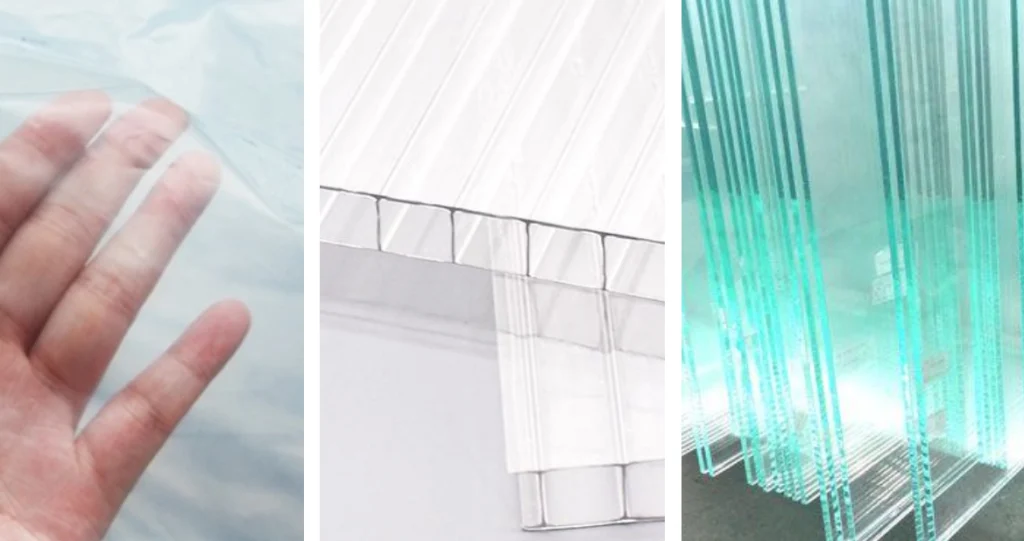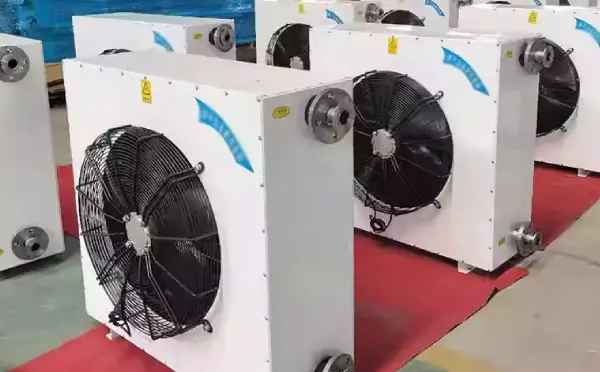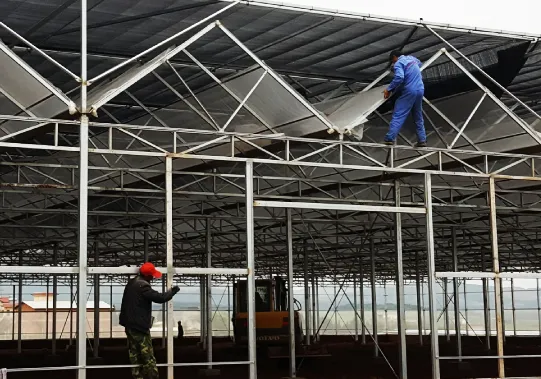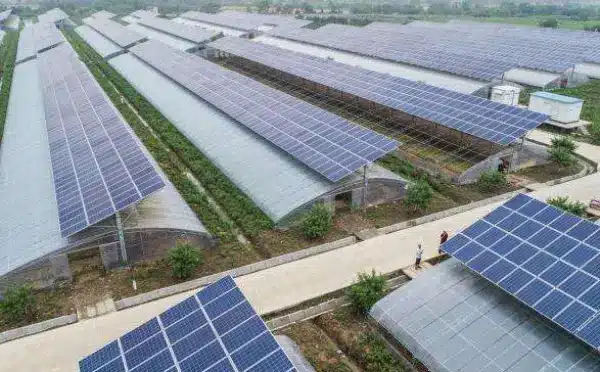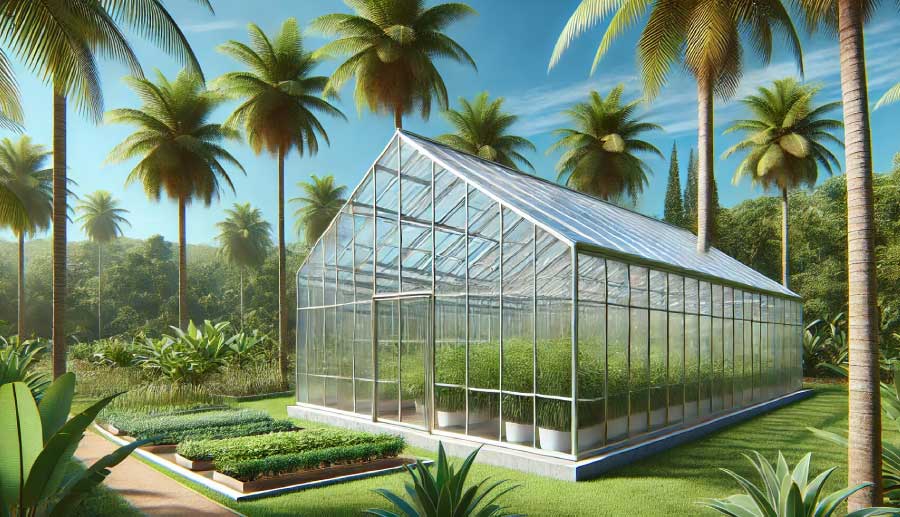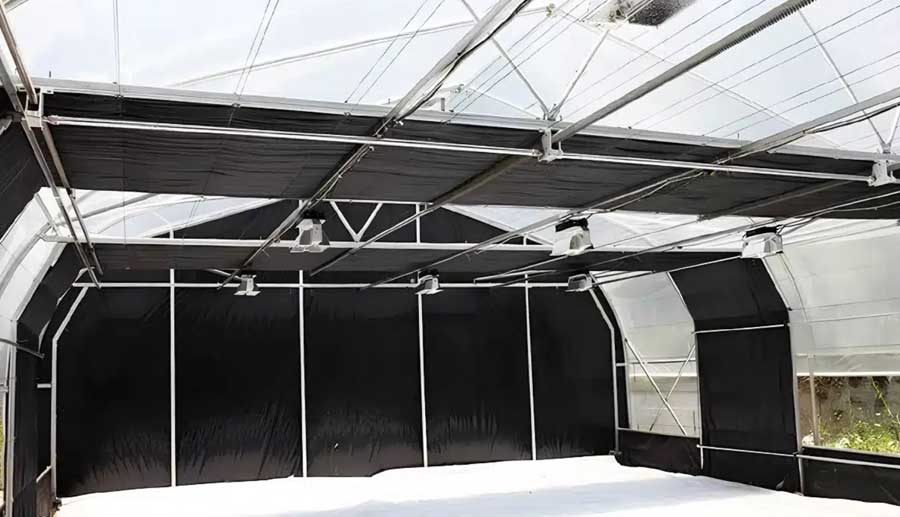In modern agriculture, climate-controlled greenhouses are a major innovation. These greenhouses precisely control temperature, humidity, and lighting, making farming more efficient and predictable. They can keep ideal conditions in almost any climate, allowing plants to grow year-round for both beauty and food.
Don’t Miss: 18 Types of Commercial Greenhouses You Should Know
However, setting up and maintaining a climate-controlled greenhouse is not easy. The costs can be high for some farmers and hobbyists. This article explores the costs of starting and running a climate-controlled greenhouse, including initial investments and long-term expenses. It also offers tips on maximizing your return on investment and using energy efficiently.
This information will help you plan your greenhouse project better. For the latest quotes on automated greenhouses, feel free to contact us directly.
The Basic Concept of Climate-Controlled Greenhouses
Everyone understands a climate-controlled greenhouse differently. Before we discuss the costs, let’s define what a climate-controlled greenhouse is so we’re all on the same page. This helps us calculate costs based on its functions and standards.
So, what is a climate-controlled greenhouse?
A climate-controlled greenhouse uses advanced technology to control its internal environment precisely. Unlike traditional greenhouses, it can adjust temperature, humidity, light intensity, light duration, and even carbon dioxide levels to meet the specific needs of plants. These greenhouses have advanced sensors and control systems that automatically or manually adjust the conditions to ensure plants grow optimally.
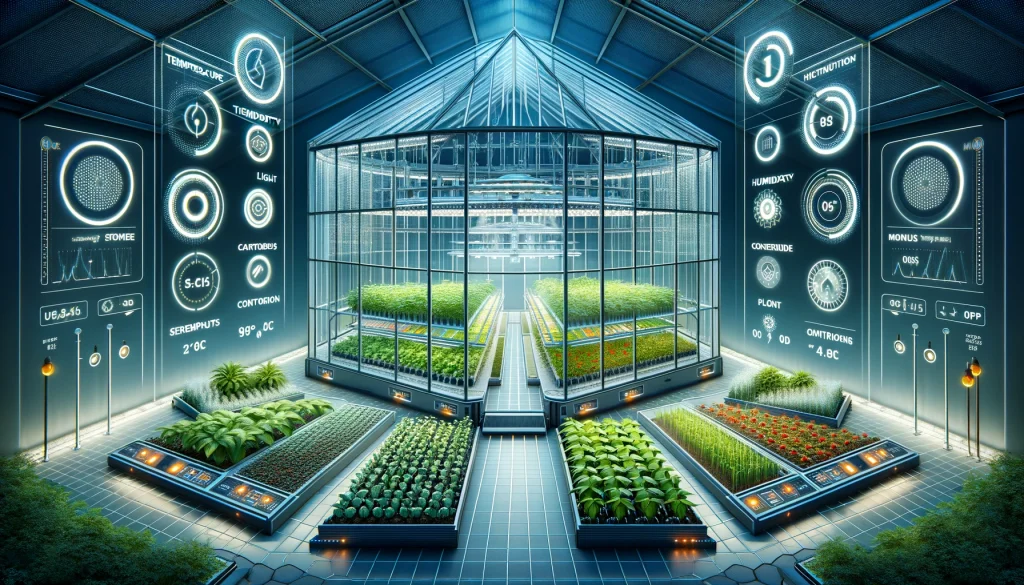
Advantages of Climate-Controlled Greenhouses
Different crops need different conditions at various growth stages. Climate-controlled greenhouses can be adjusted to meet these specific needs, offering solutions that provide ideal conditions year-round, no matter the external climate.
These greenhouses can significantly boost the yield and quality of crops by providing a stable and suitable environment all year round. They have excellent cross-regional planting capabilities, allowing vegetables and fruits to grow in harsh climates like deserts and high-altitude areas. Additionally, some of these greenhouses are being developed for extraterrestrial use, aimed at environments like outer space.
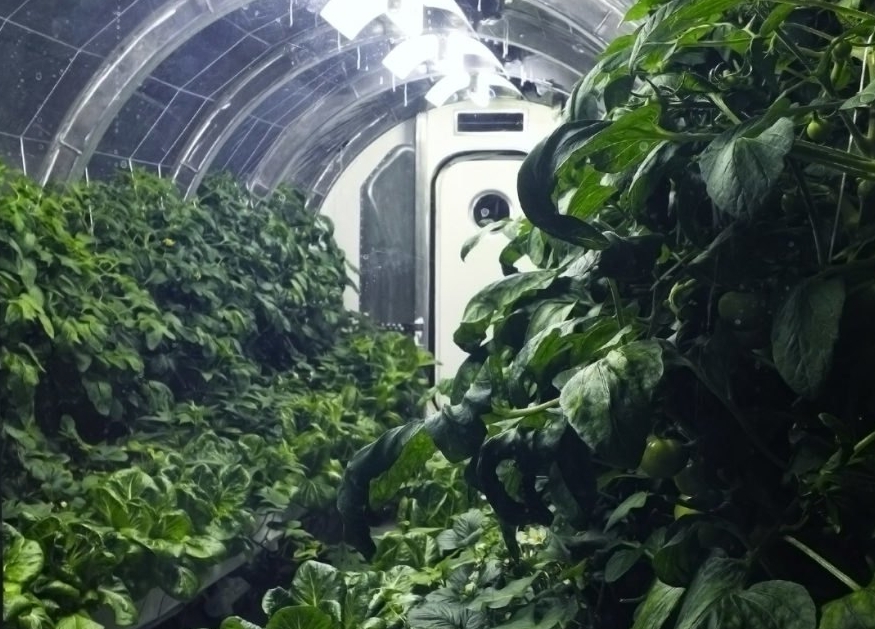
Breaking Down the Climate-Controlled Greenhouse Construction Cost
A key aspect when evaluating the cost of a climate-controlled greenhouse is understanding the breakdown of construction and operational expenses. Let’s first discuss the costs involved in building a climate-controlled greenhouse.
Building a greenhouse involves several steps, from leasing or buying the site, and choosing framework and covering materials, to installing control systems and sensors. Each component comes with its own set of expenses. Understanding these cost factors is crucial for effective greenhouse planning and budgeting.
So, what cost factors do we need to consider?
- Size and Design: The size and design of the greenhouse directly affect its total cost. Larger greenhouses require more materials, a more complex control system, and higher site preparation costs, but they can yield higher production. The layout should focus on functionality and energy efficiency to maximize space and productivity.
- Materials: The cost of materials used in constructing a greenhouse can vary greatly. Traditional glass greenhouses are aesthetically pleasing but expensive and fragile. Plastic films or polycarbonate panels are more economical but may need more frequent replacement. When choosing materials, consider their durability, light transmission, and insulation properties. Get more info about what is the best material for greenhouse covering >>

Types of Greenhouse Materials - Systems: Advanced control systems for temperature, humidity, and lighting are essential for a climate-controlled greenhouse. Efficient heating, cooling, and ventilation systems can reduce long-term operational costs. The complexity and technical level of these systems impact the initial investment. While these systems typically have a higher upfront cost, they can save on labor costs and improve efficiency in the long run.

Hot Air Blower System - Labor: Labor costs are a significant consideration, covering everything from preparing the greenhouse’s foundation to transporting and installing materials and equipment.

Build A Greenhouse
In addition to the cost factors mentioned earlier, constructing a greenhouse involves other necessary expenses, such as site leasing and permits. Overall, the cost of a well-equipped 10,000 sq ft climate-controlled greenhouse can range from $200,000 to $300,000. However, prices may vary in different countries and regions depending on local labor and material costs. For example, costs can be significantly lower in regions like China, and you can consult us for more detailed information.
Next, we can get an understanding of the price range for various components of the greenhouse through a chart shared by INSONSHADE:
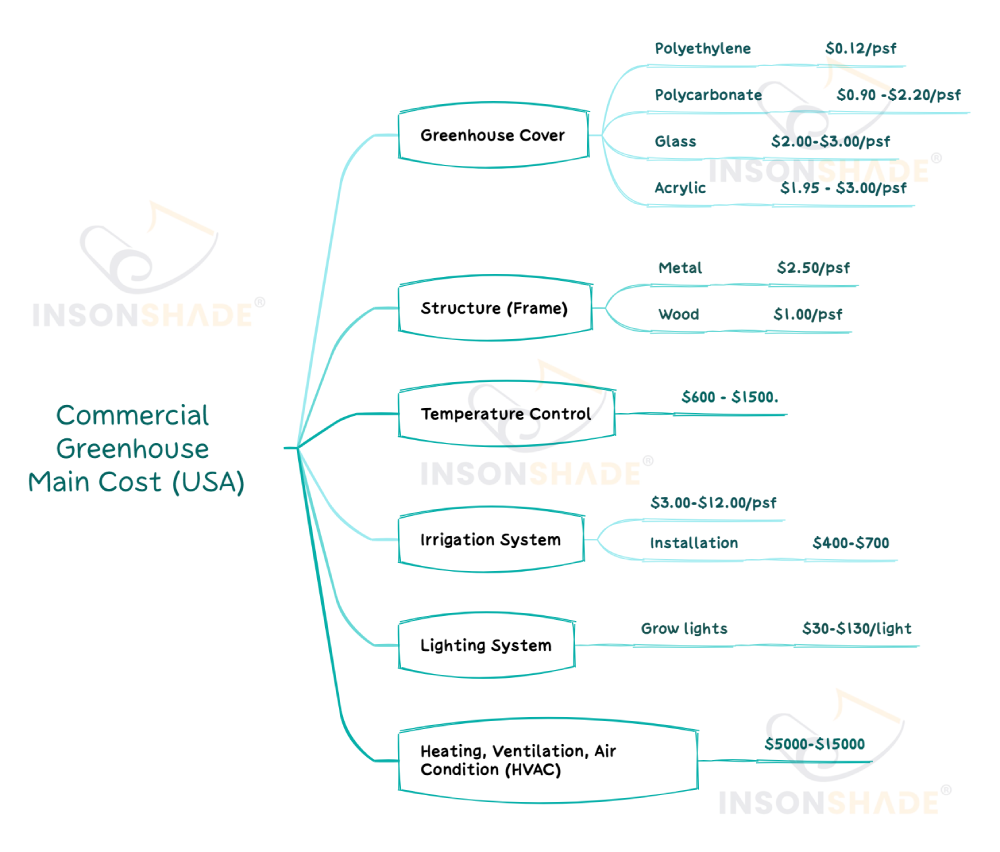
Maintenance Cost of Climate-Controlled Greenhouses
Climate-controlled greenhouses require ongoing operation and maintenance to ensure they function effectively over the long term and achieve maximum production efficiency. So, what operational and maintenance costs need to be considered for these greenhouses?
Let’s take a look:
- Energy Consumption: Heating, cooling, lighting, and ventilation systems consume a significant amount of energy, making energy costs one of the primary expenses in operating these greenhouses. Opting for energy-efficient equipment and optimizing energy-use strategies can significantly reduce these costs. Where possible, utilizing renewable energy sources like solar or geothermal energy is advisable.

Solar Collectors - System Maintenance: Regular maintenance is key to keeping the greenhouse operating efficiently. This includes inspecting and repairing control systems, replacing worn-out parts, and ensuring structural integrity. This is mainly a labor cost, requiring the hiring of 1-2 people for regular maintenance.
- Plant Care Costs: Another significant expense in climate-controlled greenhouses is plant care, including water, fertilizers, pest and disease management, and labor. These costs vary depending on the type and scale of crops grown.
- Technology Upgrades and Replacement: As technology evolves and greenhouse equipment ages, there may be a need for technological upgrades or equipment replacement, which incurs additional costs.
- Other Potential Costs: You may also need to purchase commercial insurance for your cultivation. Moreover, costs are related to the size of your greenhouse and the plants you grow. Some plants may require stricter greenhouse control, thus incurring more costs in energy consumption and plant care.
Due to the many factors involved, which are related to the systems equipped in the greenhouse and the plants grown, it is challenging to provide a complete cost estimate. For instance, the cost per unit of electricity and per liter of fuel varies, and if you’re using renewable energy sources, the initial investment might be higher, but subsequent energy costs would be lower. Hence, some analysis is needed.
Impact of Geographic Location on Greenhouse Costs
The climate and environmental regulations of different geographic locations vary greatly. Under different climates and local agricultural policies, climate-controlled greenhouses face varying challenges. The required materials and systems differ accordingly, significantly affecting the construction and operational costs of greenhouses.
- Impact of Temperature on Costs: For instance, greenhouses in colder regions need more robust heating systems, while those in hotter areas require cooling and ventilation systems. The degree of temperature variation affects system requirements and, consequently, costs.
- Impact of Sunlight on Costs: The duration and intensity of sunlight at the greenhouse location affect the need for artificial lighting, which in turn influences energy consumption and costs. For example, in high-latitude areas with short daylight hours in winter, there is typically a greater need for lighting, resulting in higher electricity consumption.
- Impact of Local Resources on Costs: In some areas, it might be easier and cheaper to obtain specific greenhouse building materials or technology, like in the region where our factory is located. In contrast, in areas with high labor costs, greenhouse materials can be more expensive. Additionally, some regions have natural energy advantages, such as solar, geothermal, or oil, which can be beneficial for greenhouse operations.
- Impact of Policies and Regulations on Costs: Environmental regulations and building standards in different areas also affect greenhouse design and operation. Complying with local regulations might add certain costs but can also ensure sustainability and safety.
In summary, when establishing a climate-controlled greenhouse, it is crucial to fully understand and assess the unique conditions and needs of your geographic location. Utilizing local advantages in designing and creating your greenhouse can better control costs.
Cost-Benefit Analysis of Climate-Controlled Greenhouses
When investing in a climate-controlled greenhouse, it’s essential to estimate construction and operational costs based on the factors mentioned above. Additionally, calculate the yield and revenue from your crops to determine your return on investment. For most fully-equipped climate-controlled greenhouses, the initial investment is high. However, by increasing crop yield and quality while reducing long-term operational costs, the investment can yield substantial returns.
Conclusion
In summary, establishing and maintaining a climate-controlled greenhouse requires a significant initial investment and higher operational costs compared to traditional low-tech greenhouses. However, the agricultural output is also higher. With continuous technological advancements and cost reductions, these greenhouses are expected to play a vital role in global agriculture and become a mainstream cultivation method.
If you’re considering investing in greenhouse agriculture, contact us for more information about climate-controlled smart greenhouse construction solutions and costs. Our factory, located in the industrially developed and resource-rich southwestern part of China, offers greenhouse construction solutions that provide excellent value for money.
